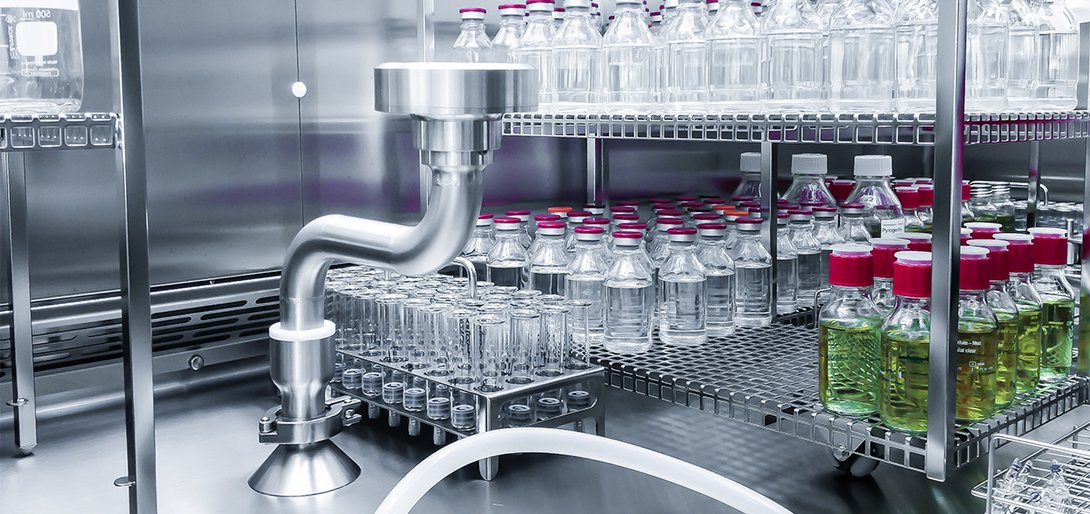A close look at germs
Vacuum cleaners are not only used in people’s homes. They are also deployed in clean rooms – specifically in the form of “Microbiology air-sample in process” (asip) technology. Read on to find out how exactly this technology works and why it is a must-have for pharmaceutical companies.
Every cleaning professional needs a powerful vacuum cleaner. Nowhere is this more true than for clean rooms in industrial production. In this environment, the vacuum cleaner principle is used as part of a technology called “Microbiology air-sample in process” (asip). The process was developed by HAS Technologie GmbH, which was acquired by Waldner in July 2022. Previously, HAS had been a close partner of Waldner’s Process Systems division for many years and supplemented its products primarily with innovative automation solutions.
Their range now includes asip: a system that tests the sterility of air in clean rooms with high precision. This is important for a wide variety of industries that produce in clean rooms, such as the food sector or semiconductor manufacturing. However, the most stringent regulations by far regarding aseptic production in clean rooms apply to the pharmaceutical industry. Good Manufacturing Practice (GMP) places particularly high demands on the production of pharmaceuticals. Accordingly, operating a pharmaceutical production area requires a seamless approach to measuring airborne germs in order to ensure the highest degree of sterility.
Targeted prevention of drug contamination
According to these guidelines, the air in clean rooms must not contain any germs (colony-forming units). If such germs are found, however, the drugs being produced are at risk of contamination. In this case, they would have to be segregated and withdrawn from sale, causing substantial financial losses for the affected companies. This can only be prevented with reliable measurement techniques. And that’s exactly where asip steps in with state-of-the-art functions. The system sucks in exactly one cubic meter of air like a vacuum cleaner. The suction process is carried out via a measuring probe that protrudes into the clean room and basically acts like an animal’s nose. It checks whether the area was or is currently contaminated with germs.
Crucially, the air must be sucked in at a precisely defined speed so that exactly six cubic meters per hour pass through the suction pipe. If the speed is not consistently maintained, germs may die and distort the results. The germs contained in the probed air, if any, are collected in a Petri dish (agar plate). This technique is known as the impaction method. The suction speed of 6 m3/h causes the germs to land on the agar plate according to the principle of inertia while the air is directed around the plate. After a certain incubation period, it is possible to reliably determine whether cultures of dangerous germs have grown in the nutrient fluid of the agar plate – and if so, which ones. If no colony-forming units are detected, the drug may be released for sale. In the event of a positive result, however, it is possible to specifically investigate the causes of contamination. In addition, measures can be developed to effectively prevent future contamination.
Removing “dirty technology” from the clean room
asip offers clear advantages over other measurement methods; for example, it reliably prevents cross-contamination. With conventional measuring methods, it is common practice to bring mobile handheld devices into the clean room through air locks intended for personnel or materials. This step can introduce contaminants into the protected area. “Our goal was to completely eliminate dirty technology from the sterile environments at pharmaceutical companies. With asip, only a permanently installed measuring probe protrudes into the clean room, which categorically rules out cross-contamination,” explains Bernd Schlegel, Head of Sales and Purchasing at HAS Technologie GmbH. This principle can also reliably prevent self-contamination of the measuring components.
Another advantage of asip technology is its high level of reproducibility: the system precisely measures the standard volume of air and flow rate. It is therefore possible to consistently maintain the amount of air drawn in and thus the speed of the air flow. This is particularly important for pharmaceutical companies, as they must always ensure reproducible processes in accordance with GMP guidelines. In addition, asip is highly resistant to the disinfectant hydrogen peroxide (H2O2), which is commonly used in laboratory environments.
Measuring system seamlessly integrated into insulators
And last but not least, the measurement technology can be easily and seamlessly integrated into machine control systems that are connected via human-machine interfaces (HMI). With asip-compact, HAS has also developed a special system for insulators, which are frequently used in clean room environments. The measuring probe is located within the aseptic area and can be swivelled, saving space and simplifying handling. Insulator manufacturers can easily and conveniently integrate the system into their machines and their existing machine control software using a wide array of available interfaces. The technology is also able to specifically identify sources of interference in the insulator – such as a ruptured hose or a damaged sensor – and generate corresponding error messages.
